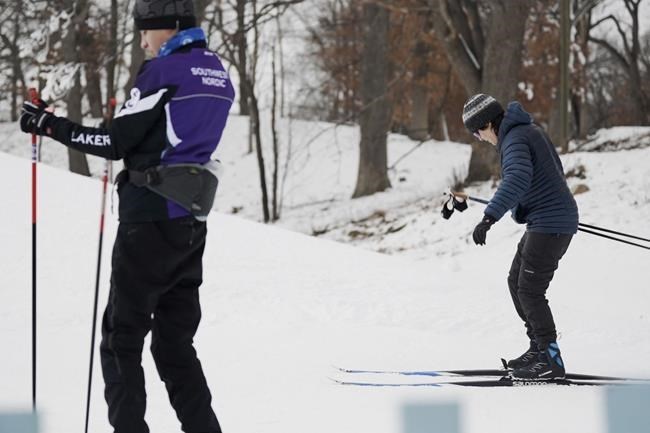
Cross country skiers prepare to hit the trails at Theodore Wirth Park on Thursday, Jan. 18, 2024 in Minneapolis, Minn. As a bout of bitter and deadly cold sweeps the U.S., millions of Americans are being told to dress in layers if they must go outside. (AP Photo/Mark Vancleave)
January 19, 2024 - 10:26 AM
MINNEAPOLIS (AP) — As a bout of bitter and deadly cold sweeps the U.S., millions of Americans are being told to dress in layers if they must go outside.
In places that rarely experience bone-chilling temperatures, that advice can be confounding. What does it mean to layer up? Is it different from just putting on a coat? Is there a way to do it wrong?
People in Minnesota, a state that is no stranger to the cold, have wisdom to share.
WHAT IS LAYERING?
Layering means wearing multiple pieces of clothing to keep your body comfortable in cold weather. Each layer creates an insulating pocket of air that protects you better than just wearing a big jacket, and layering helps move sweat and moisture away from your skin.
No matter how cold it is, you’re probably going to sweat when you go outside and start moving, said Claire Wilson, executive director of The Loppet Foundation — a nonprofit that promotes winter recreation and activities in Minneapolis.
If you're wearing the correct layers, you can feel perspiration wick away from your body, she said. The idea is to add another layer if you get cold, or take off a layer when you get hot or wet.
AVOID COTTON AND WETNESS
Wilson said she loves to shop at thrift stores for layers that won't break the bank.
“Just look for things that aren’t cotton,” she said.
Cotton absorbs moisture, so it stays wet longer, Wilson explained. Cotton socks can get wet in your boots or shoes if you walk in the snow, and a cotton shirt under your jacket can get wet with sweat. Cotton won't dry quickly, so you'll get colder, she said.
Instead, choose wool socks and fabrics made of fleece, polyester or polypropylene, she said. You can also repurpose old vests and shirts, which are great at keeping your core warm. Many of these items might also already be in your closet; layering up doesn't have to cost a fortune.
THINK OF THREE MAIN LAYERS
Wilson recommends starting with a base layer, then a mid layer, and then an outer layer.
The base layer is closest to your skin, so it's important for the fabric to wick away moisture, she said. Choose polyester over cotton for this. Then, wear a mid layer — a vest or a shirt — to keep your core warm. Some people choose to wear more than one mid layer. Finally, wear a traditional winter jacket that breaks the wind a little but also insulates you, Wilson said.
DRESS TO PREVENT FROSTBITE
Frostbite — a painful injury in which skin freezes, blood flow decreases and tissue gets damaged — can happen within minutes in cold weather when skin is not adequately covered.
“We see people with frostbite inside their shoes and gloves all the time,” said Dr. James Miner, chief of emergency medicine at Hennepin County Medical Center in Minneapolis.
Symptoms include blistering of the skin because it's damaged, along with bruising and swelling. Frostbite can even result in the loss of a limb, if it's not properly treated.
The hospital sees about a dozen people a day with frostbite when temperatures hover near zero (minus 18 degrees Celsius), Miner said.
Layering up can prevent frostbite because it traps a bit of insulating air between each layer of fabric, Miner said. It's more effective than simply wearing a big coat because layers “tend to keep the moisture from outside — or the moisture from your body — from traveling as far as it gets trapped” by the air within each layer.
Miner recommends a waterproof outer layer, like a raincoat, to keep the lower layers dry.
Children typically require one more layer than adults, said Toni Hauser, supervisor of emergency preparedness and response for the Minneapolis Health Department. Hauser suggests keeping extra clothing or blankets in your car as well, in case you run out of gas or your car breaks down and you need to be outside.
PROTECT SPECIFIC BODY PARTS
“Three words: Cover Your Bum (CYB)!” the city of Minneapolis says in a blog post about staying warm in cold weather. In other words, wear a winter jacket that falls closer to your knees than your hips.
The post also recommends keeping your legs warm with fleece-lined leggings or a pair of long underwear under your pants. Woolen socks and winter boots are a big help, too. Fur-lined gloves or mittens can also keep your hands warm and prevent dry skin. And keep your ears cozy with ear muffs or a hat.
___
Trisha Ahmed is a corps member for the Associated Press/Report for America Statehouse News Initiative. Report for America is a nonprofit national service program that places journalists in local newsrooms to report on under-covered issues. Follow her on X, formerly Twitter: @TrishaAhmed15
News from © The Associated Press, 2024